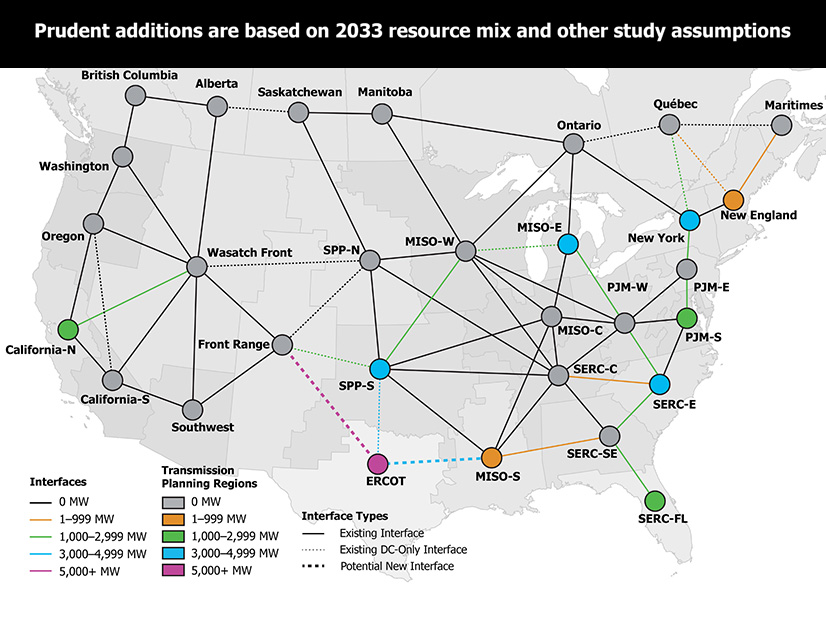
The Eastern Interconnection Planning Collaborative on Feb. 24 urged FERC to not use NERC’s Interregional Transfer Capability Study (ITCS) “as a metric for determining prudent additions” to transfer capability on the grid (AD24-5).
In comments filed with the commission on the study, EIPC — an association of 18 planning authorities from the Eastern and Central U.S., including PJM, ISO-NE, NYISO, Duke Energy, Dominion Energy and the Tennessee Valley Authority — also commended NERC for the “enormous task” carried out by the ERO in a short time frame, and thanked the organization for working with industry stakeholders during the study.
NERC submitted the final installments of the ITCS to FERC in November, ahead of the December deadline set by Congress in the Fiscal Responsibility Act of 2023. (See NERC Files ITCS to FERC, Meeting Congress’ Deadline.) In the FRA, Congress directed NERC to submit to FERC a study detailing current transfer capabilities across the North American grid, recommendations for prudent additions to transfer capability that could strengthen grid reliability, and recommendations to meet and maintain total transfer capability.
The ERO’s final report, submitted in three parts — with a fourth component focused on Canada planned for release this year — recommended a total of 35 GW of additional transfer capability across FERC’s transmission planning regions. NERC Director of Reliability Assessments and Performance Analysis John Moura said the ERO had to use its discretion to narrow the FRA’s broad requirements to a workable framework; for example, NERC’s definition for “prudent” additions focuses on reliability rather than economic factors.
EIPC’s comments acknowledged that NERC had “relatively little time to develop a study methodology, gather the required data, consult stakeholders, execute the study and validate results” and that the limited time required the ERO to “change and reduce the scope of its study.” EIPC also said it appreciated that NERC went out of its way to coordinate with grid stakeholders through the ITCS Advisory Group.
However, the collaborative did express concerns about the study — partly regarding its methodology, but mainly that large transfer capability studies like the ITCS are inherently unsuitable “to drive transmission upgrades on the power system.” EIPC pointed out that transmission service providers (TSPs) and transmission planners “have a more in-depth understanding of the current and planned transfer capability on their system” than NERC.
“Decisions on the value of specific transmission improvements are complex, and they must consider all the factors regularly evaluated by TSPs, transmission planners and resource planners,” EIPC said. “This goes beyond the factors considered for transfer capability in [large transfer capability studies]. For example, available capacity, the feasibility of upgrades, the potential for excess generation and cost allocation must be considered to ensure investments are prudent and aligned with a beneficiary-pays methodology.”
EIPC emphasized that it “shares the same goals as FERC, NERC and the rest of the industry” regarding improving grid reliability through interregional transfer capability, and that it also believes investments in transfer capability can add value to the grid “at appropriate costs.” However, it also cautioned that despite providing “interesting insights,” large-scale “snapshot-in-time” studies like the ITCS lack “the appropriate granularity” to make useful recommendations.
Calling the ITCS “not directly actionable,” EIPC suggested that federal and state regulators and policymakers seek input from “planning entities responsible for analyzing transmission security and resource adequacy needs” when determining interregional transfer capability needs. In addition, EIPC said that prudent additions should be assessed in terms of cost, not just their reliability benefits.
EIPC also recommended that FERC work with state regulators on metrics to guide decision-making on increasing interregional transfer capability. The collaborative stopped short of defining the metrics itself but suggested that they include factors such as specific needs that a proposed expansion could address, whether the potential reliability benefits exceed the projected cost of the project, and the feasibility of the proposed project to meet the identified need.
In a separate statement, EIPC said its members “stand ready to provide technical assistance” for the Eastern Interconnection if FERC decides to pursue such a metrics project.



